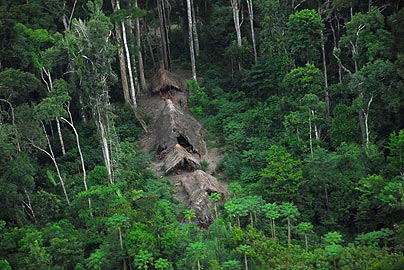
PRE-VIEWING ACTIVITIES

Before explaining the topic of the class, show students the above photo. Tell them to reeeally look at it, and discuss what they can see. Some of them might make out small huts in the middle of the jungle, some of the more eagle-eyed might spy a few figures. A bright spark may identify it as an indigenous people’s village in the jungle, and could possibly even infer that it’s likely to be in the Amazon rainforest. Brownie points all round. Tell them that uncontacted people or lost tribes are isolated people who live either by choice or by circumstance, without significant contact from globalised civilisation, if at all.
Ask the students to have a quick chat about what comes to mind when they think of these places, under the headings:
- Where do they live?
- What do they look like?
- How do they dress?
- How do they communicate?
The class compares answers, perhaps even drawing a sketch on the board of what they imagine.
Using these same headings, tell the students that they are about to watch a clip of a lost tribe emerging from the jungle for perhaps the first time, and that you’d like to make notes about the peoples in question, plus with one more heading: What are they in danger from?
Transcript (for teacher’s use, or for weaker students)
Show transcript
Later the group entered the village. Employees of FUNAI, Brazil’s indigenous department, filmed the men and warned them not to take anything, for fear they might fall ill. But they still took tools and clothes. The group was already carrying objects, the government officials believe, they had taken from other villages. They retreated into the forest and returned the next day. Coughing and sneezing, they had to be treated for their colds.
By choice, uncontacted indigenous groups don’t normally reach out to people outside their tribe. That’s why Brazilian experts say that these men could possibly be looking for help. Some speculate that they might have crossed the borders from Peru because of pressures from illegal loggers or drug dealers operating in the area.
POST-VIEWING ACTIVITIES
Review and discussion
Students discuss the notes they’ve made. Lower levels may need a couple of times to hear the vocabulary coughing, sneezing, loggers and drug dealers. Have a discussion about the dangers: disease, logging, violent narcotics traffickers. Speak about how they affect the tribes, and what can be done to tackle these problems.
Key lexis
Check understanding of key vocabulary and language chunks, they will be useful in the following communicative activity. Make contact, release a video, settled community, for fear they might fall ill, treated for their colds, by choice, reach out.
Communicative activity: Debate
Split class into three groups. The first group represents FUNAI, Brazil’s indigenous department. They believe that the tribes should be actively kept away from civilisation for as long as possible, and that the positive aspects of modern life don’t outweigh the dangers they would face and the loss of their traditional way of life.
The second group represents the evil loggers, who have hired a PR firm to approach the tribe with a large settlement in exchange for their land. Their job is to argue that it is not only a generous offer, but that it is morally wrong to not encourage them to take their part in society with all its obvious benefits.
The final group (perhaps for weaker students) are the tribes people themselves. Their job is to listen to the different sides and ask questions, eventually voting on their future. The situation leads itself to some comedy, as the group must act as if they’ve only emerged for the first time in the last few hours, and are shocked at seeing everything, from a light bulb to a mobile phone!
This eLesson was created by Stephen Parsons who is currently working at the British Council in Beirut, Lebanon.

Students can be asked to explore the site SOCIETY FOR THREATENED PEOPLES (GfbV), based in Germany. It has much information on the dangers various tribes, indigenous peoples and minorities face. Within the core English-speaking countries founded by British colonialism (esp. Australia, NZ, US, Canada), there are many threatened smaller peoples, languages. Students can divide into groups of three and search for such a group, deciding to learn more about it. Groups can then present their findings to the larger class.
Ethnologue of SIL (Summer Institute of Linguistics) states there are 7,100 living languages. Many of these are threatened with extinction or marginalization. Ask students to explore the Ethnologue site. What languages in their own country are listed there, perhaps some they have never heard of? Why are such languages worth preserving, and how can this be done?
The United Nations Declaration on the Rights of Indigenous Peoples (2007) is an important document. Students at B2 level can search the document and in small groups, present some of the main points. What rights are protected? Some countries, such as India, have many 100s of such ‘indigenous’ peoples. Are there any or many such indigenous human communities where you teach? Their situation and well-being are a national issue, or should be.
August 9 is UN Indigenous Day Students can be introduced to the very engaged survivalinternational(dot)org Many different indigenous situations described there, an activist site. They also have something on the focus of this lesson, this Amazon tribe.